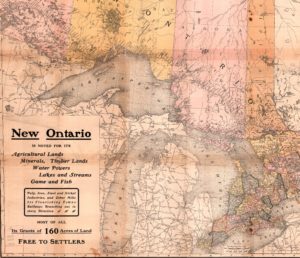Land Grants to Settlers

When the government of Canada and Ojibwe leaders signed Treaty 3 in 1873, the Rainy River District was incorporated into the province of Ontario as Crown Land. In 1886, the Ontario provincial parliament passed the Rainy River Free Grants and Homesteads Act, legally adopting the land surveys of the district, and allowing the Lieutenant Governor of Ontario to appropriate any land in the region for free grants to settlers.
This legislation built on an 1860 Upper Canada Public Lands Act. A man, or a woman if she was the sole head of a family, could be given a free plot of land by the province, with the expectation that they would increase its productivity through farming and settlement. Settlers who had already been occupying land were granted full private property rights over the area they had ‘improved’.
All surveyed land in the Rainy River District was made available to settlers for either homesteading, mining, or timber. Even Indian Reserves could be declared subject to the Public Lands Act. Land was considered unoccupied unless it was converted into natural resources, farmland, or real estate. This was a cosmology of land that valued resource extraction and agricultural productivity over a long history of human relationships with land, ancestors, and animals.